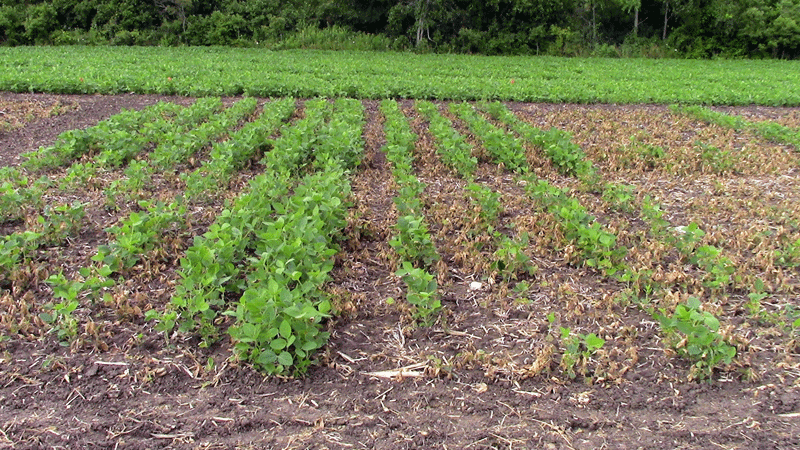Cropside: Feeling the pressure? Good!
AGRONOMIC INFORMATION FROM ONTARIO'S CROP SPECIALISTS

FULL DISCLOSURE – I come from the horticultural side of the fence. In that world, sprayer operators are more likely to consult analog pressure gauges somewhere near the pump on their tow-behind boom or airblast equipment. Rate controllers equipped with a transducer-style digital pressure gauge are more often found in field crop operations. I wonder if the horticulture guys should be envious or not, given the unquestioning trust field sprayer operators place in rate controllers.
PHOTO: A DEMONSTRATION PLOT OF SOYBEANS SPRAYED WITH THE CONTACT HERBICIDE ERAGON. THE BOOM WAS 50 CM ABOVE THE TARGET, WITH AIR BUBBLE JETS ON 60 CM SPACING, OPERATING AT 0.7 BAR (10 PSI). YOU CAN SEE THAT THE COLLAPSED PATTERNS DID NOT OVERLAP AT THE RECOMMENDED 100% TO GIVE CONSISTENT COVERAGE. EVEN AT 30 PSI, MISSES WERE EVIDENT BECAUSE THE PRESSURE WAS TOO LOW TO CREATE ENOUGH DROPLETS FOR CONSISTENT COVERAGE.

Pressure is a critical factor in determining the rate and the spray quality (i.e. median droplet size and spray pattern) of a nozzle. When a nozzle is operated at the lower end of its manufacturer-recommended range, the spray pattern tends to collapse and may compromise coverage. This is of particular concern with the wide-angle air induction fans most sprayer operators favour (photo).
The first step is to confirm that your gauge is accurate, and you do that by comparing your current gauge to a “true” gauge. You can build a simple tester (see how to build it here: http://sprayers101.com/confirm-sprayer-pressure/), or tee-in a redundant gauge on the sprayer and watch for inconsistencies. Be aware that new, off the shelf gauges could be off by a few psi, so buy a few, test them against one another, and return the inaccurate ones to the dealer. Don’t ask what the dealer does with them…
The second step is to look for the inevitable pressure drop between the main gauge or transducer (often located just after the pump, but before much of the plumbing, valves, hoses, connectors, elbows, and solenoids) and the nozzle body where the pressure really matters. To check, tee a gauge into the boom section, or use a fitting to replace a nozzle with a gauge (refer to the above noted web page for instructions on how to do this). Open the boom, and with all sections operating at your typical pressure, check the pressure at each section. If you see an average difference of, for example, 5 – 10 psi, raise your operating pressure (or raise the bottom limit on your rate controller) to compensate.
A quick word on calibrating digital pressure sensors – the specific method is brand-specific, but all manufacturers recommend doing so annually. The process involves ensuring there is no pressure at the sensor to establish a zero set point, and then consulting an analog gauge teed-in at the boom to establish a second set point around your anticipated maximum pressure. This gives a voltage-to-pressure ratio in mV/PSI and the software does the rest.
Take homes:
1) Confirm the accuracy of your gauges, digital or analog, annually.
2) Compensate for the pressure drop between your main gauge and the actual boom pressure.
3) Operate your nozzles in a range that ensures spray quality is not compromised, particularly at the low-end. •






















